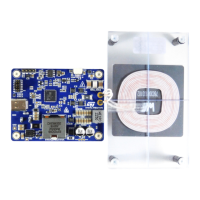3.2 Basic operating modes
STWBC2 is designed to work in transmitter mode only. Once the board is powered up, the device automatically
starts performing analog ping. This means that the STWBC2 is periodically measuring the Q factor on the transmit
coil. The presence of a magnetically susceptible object on the coil changes the measured Q factor. Based on the
Q factor measurement result, the device distinguishes three states:
• No object present
• Foreign object present
• Rx coil present
If the result of the analog ping indicates the presence of a power receiver, the device initiates a digital ping. During
the digital ping, the Tx emits a short period of power signal and waits for a valid ASK response. If a suitable
response is received, the STWBC2 proceeds to power transfer. If the received ASK communication is not valid or
if the receiver is removed from the power interface, the device returns to the ping phase.
3.3 Status LEDs
There are two LEDs present on the STEVAL-WBC2TX70 board. The red and green LED indicates the device
status as per the following table:
For more details about the device status, use the event box of the GUI.
Table 3. Status LEDs meaning
State Red LED Green LED Meaning
At startup
Short blink Power on calibration done
On On
Waiting for AFE initialization done.
Initialization blocked by invalid Vin.
During operation
Off Off No signaling–nothing present at Tx coil
Off Blinking at a normal rate Charging in BPP
Off Blinking at a fast rate Charging in EPP
Off Blinking at a slow rate
Charging at a reduced rate (Tx does not support power requested by
Rx).
Off On Charge complete (EPT/cc received), power transfer stopped.
Blink Off Charging stopped, ping will resume after timeout
On Off
Charging stopped, ping resumes when objects (Rx, FO...) are
removed from the Tx coil
UM3286
Overview of the board
UM3286 - Rev 1
page 7/84

